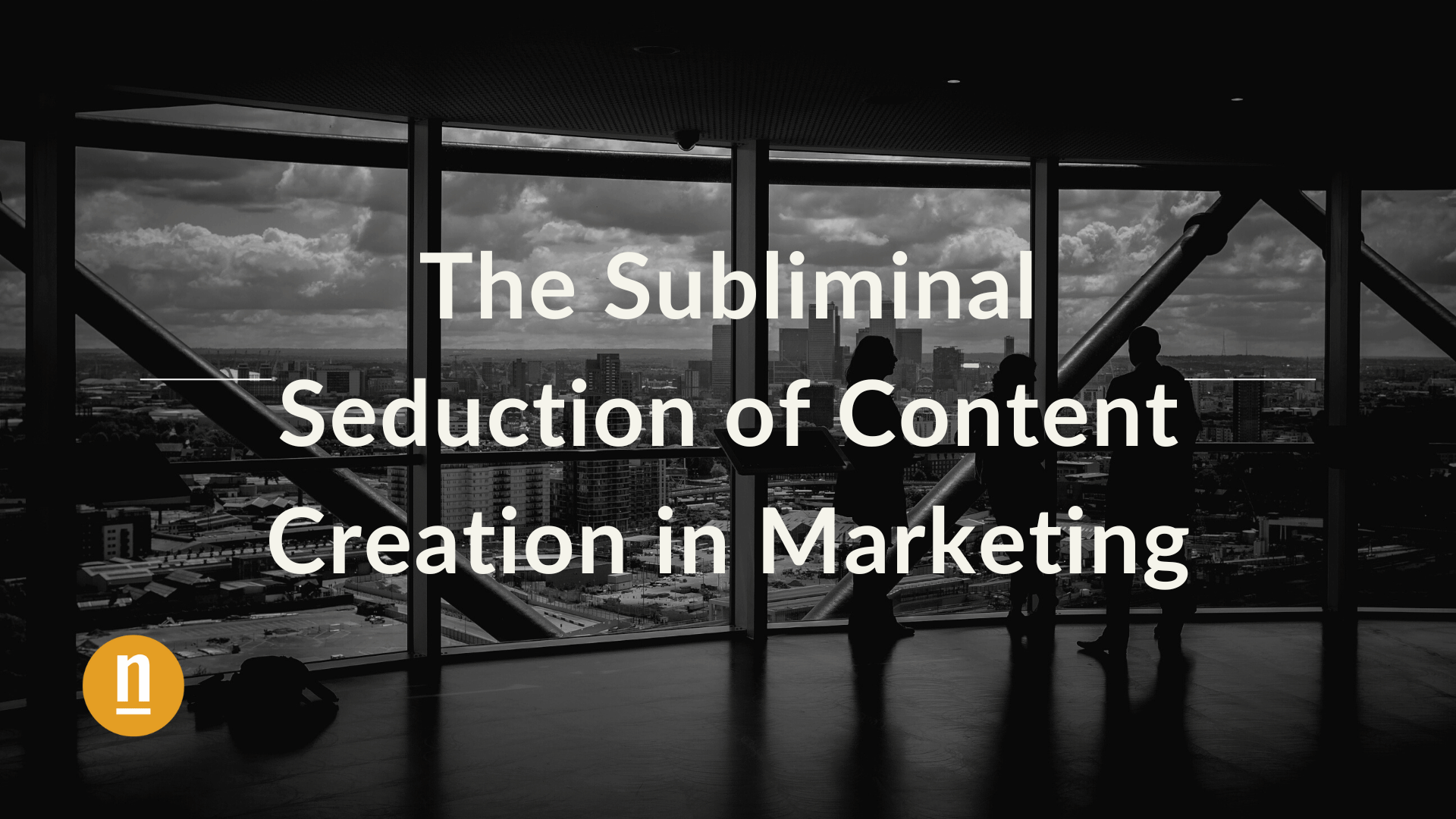 Does content creation in advertising include subliminal messages?
Does content creation in advertising include subliminal messages?
In 1973 the book Subliminal Seduction introduced to the mainstream the idea that brands were using subliminal messages to trick consumers into making decisions and purchasing products. The public was in a state of fear. The Federal Communications Commission held hearings to discuss the legality of subliminal advertising. Presidential campaigns used subliminal messages in an attempt to influence voters. Meanwhile, nobody was able to determine whether these messages actually worked (they don’t).
Brands can (and have) embedded hidden images and messages into their advertising – with Coca-Cola being the classic example – but these tactics, however intriguing, cannot subconsciously compel a person to take a specific action. If they could, everyone reading his post would now go and become an nDash customer.
Hey, it doesn’t hurt to try.
But as Susannah Locke of Vox.com recently noted, “subliminal messages are giving people a little nudge, not overwhelming their motivations.”
We’ll go over exactly how this works in more detail, but the real question should be, is advertising the right medium for delivering subliminal messages?
In today’s post, I wanted to show how content marketing can and should benefit from these same psychological principles as its use increases and advertising’s effectiveness decreases. Specifically, we’ll look at the similarities between subliminal advertising (in theory) and content marketing (in practice). Let’s take a closer look:
The Indirect Route to Content Creation.
The rise of content marketing (and inbound marketing) can be attributed to the buyer’s growing disdain for the hard sell. They don’t want to be told what to buy or when to buy it; they want to feel as though they arrived at that decision on their own. Knowing this, smart brands have abandoned the direct “buy now” mentality in favor of a more indirect approach. Like the subliminal advertiser, the content marketer also wants a consumer to take action but understands that the buyer must be “nudged” into this decision.
So instead of placing hidden images into advertisements, the number one content marketing goal for 77% of B2B marketers is generating brand awareness. The content marketer masks their hard sell in the form of thought leadership, commentary, and opinion. With blog posts, whitepapers, webinars, and other forms of content not overtly specific to the brand, the content marketer nudge the buyer by alluding to the benefits of their product or service – not stating them directly.
The key to making this strategy work for your business is to actually provide real value. 80% of consumers said “authenticity of content” is the most influential factor in their decision to become a follower of a brand. Your audience knows when your “5 Tips for Managing Your IT Infrastructure” post is really just “5 Reasons to Buy Our Widget.” This type of content will gain your brand awareness, but not the kind you want.
Become a real thought leader and offer real commentary and opinions. When your audience is ready to buy, they’ll remember the value you provided and come to your company first.
Timeliness.
Recent research found that liquor store patrons bought more German wine when they heard German music playing in the store and more Italian wine when Italian music was played. But trying to blast Italian music at a little league game probably won’t encourage all of the parents to rush out to the store for wine (unless their kids are really that bad).
Psychologists have now discovered that subliminal stimuli are only effective if they appeal to the viewer’s current needs and goals.
The same is true for content marketing. Tailoring your content to your visitor’s specific wants and needs will improve its reception. According to a 2015 IBM Digital Experience Survey, 56% of marketers believe that personalized content promotes higher engagement rates. There are several ways to put this idea to work in your content creation:
- Business Needs: Delivering the right value and information is just as important as when you deliver it. What stages of the buyer’s journey does your content need to support? Nearly half (48%) of marketers support 3 to 5 buying stages with dedicated content. Your content needs to solve the problems your visitor is having right now.
- Emotional Needs: While there are always practical reasons someone might want to purchase your product or service, the content marketer understands the role that emotions play in the buyer’s journey. Will this product or service make you seem smarter in front of co-workers? Will it make you seem more industrious to your boss? The content marketer will never explicitly appeal to ego like this, but if you read between the lines, this value proposition is almost always present.
Visual Stimuli.
Subliminal advertising relies almost exclusively on visuals, hidden pictures, and images placed with an advertisement (often sexual in nature).
Effective content marketing also relies on the use of visuals; a well-designed website, an infographic, an animated video, or an eBook. There have been a number of studies into how our brains process text versus image and even on how the two work together:
- When people hear information, they’re likely to remember only 10% of that information three days later. However, if a relevant image is paired with that same information, people retained 65% of the information three days later.
- Researchers found that colored visuals increase people’s willingness to read a piece of content by 80%.
- Content with relevant images gets 94% more views than content without relevant images.
Not only can visual content improve whether your content is viewed and read, but it can also actually improve how much of your content is retained by your audience. A text-only approach to content creation (or subliminal advertising) isn’t going to cut it.
Repetition.
Advertisers use the term effective frequency to measure how many times a message needs to be viewed by its audience in order for it to be remembered. Subliminal advertising—like all forms of marketing and advertising—is all about repetition. The more times a consumer is exposed to a message, the more likely they are to purchase your good or services.
Studies also suggest that when a statement is repeated, it can be perceived as more truthful than a statement that is made less frequently.
Just as the subliminal advertiser wouldn’t rely on one image or message, the content marketer does not rely on one piece of content. Instead, they push their message out with great frequency over multiple channels in order for it to resonate. According to eMarketer, 60% of marketers create at least one piece of content each day.
This is a long, “slow burn” process, but one that is well worth the effort.
Here are a few ways to make your effort more effective:
- Hone your message down to its core elements before repeating it. It can be easy for a company creating content in a broad industry like marketing or technology to cover dozens or even hundreds of different topics. That’s not repetition; that’s noise. First, get very clear on what your core message is, and make sure that all of the content you are creating supports and reiterates that message.
- Creating new content every day and repeating your message doesn’t require you to reinvent the wheel every time. Almost 60% of marketers reuse content two to five times. You can use each piece of content in multiple mediums, such as blog posts, infographics, whitepapers, and videos. You can also generate “snackable” content, such as social media messages and images, that are based on one aspect of these assets.
Inform Your Content Community.
This all probably sounds great, but if you’re like many marketing or content managers who outsource your content, simply reading about these ideas won’t help much. Your next step should be to inform your community of writers – whether they are in-house, freelance, or guest contributors – of how your company uses subliminal seduction.
A few ways you can inform your content community:
- Identify the goals of your content marketing. If your goal is brand awareness, but you fail to inform your freelancers, it shouldn’t shock you when the content you receive back includes a hard sell.
- Share your buyer personas. If you want your content to speak directly to the goals and needs of your audience, your writer needs to know just as much about that audience as you do.
- Open your content calendar to contributions. Repeating the same message multiple times requires you to create an overarching theme. If your writers don’t know what that theme is, they may pitch you ideas that fit your industry but don’t fit your current content goals. Be specific, and you’ll get specific ideas from your community.
Final Thoughts About Content Creation in Marketing
200 million people now use ad blocking. 72% of marketers think branded content is more effective than advertising in a magazine.
Subliminal (and traditional) advertising is on its way out. That doesn’t mean that we can’t apply the psychological principles of subliminal advertising to a new form of marketing. Learn from past marketing tactics, apply them to your future content, and build your content community at nDash (one last try).
What are some other subliminal advertising ideas that we can apply to content creation?
